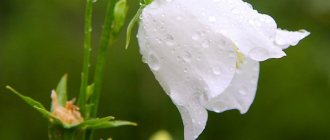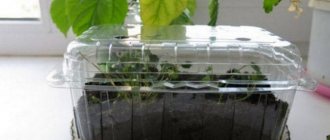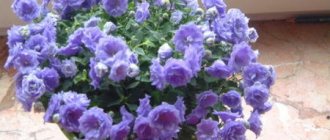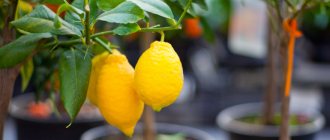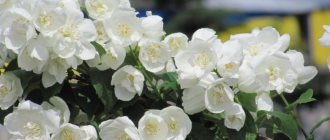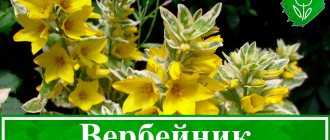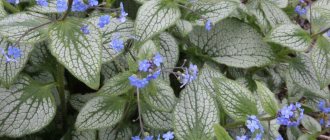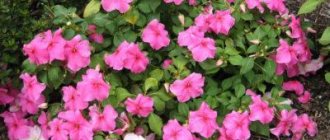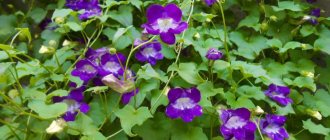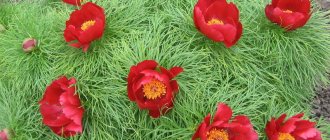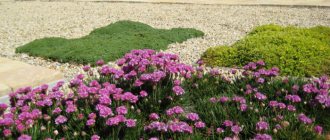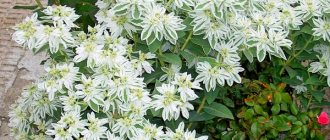Description
I met the broadleaf bellflower only once, so there is practically nothing to tell me about it. He grew up on the edge of the forest. The differences from other bells are as follows: the coarse bell and the crowded bell have capitate inflorescences, the peach-leaved bell and the spreading bell have narrow leaves, the rapunzel bell has calyxes that are bent downwards, and the nettle-leaved bell is covered with stiff hairs. All bells together can be seen in the glossary. Another representative of the bell-shaped plants is the lily-leaved bell
- distinguished by a far protruding pistil column.
Food for thought
: It seems to me that there are two different bells represented here. The doubts are as follows: the stem is smooth or ribbed, the sepals are bare or pubescent, the stem is straight, unbranched or branched almost from the base. But, as always, the directory is silent or I don’t know how to ask. According to formal characteristics, the result is the same plant. Let's take note, maybe something will become clearer in the future.
Flowers
Campanula latifolia blooms from June to August. The flowers are large, collected in a long apical raceme.
The dimensions of the corolla are impressive: the length of the corolla is 5 cm or more, the diameter of the corolla is at least 4 cm. The style is shorter than the broom, with a tripartite stigma, there is no suprapistal disc, the stamens in the form of ribbons lie at the bottom of the corolla.
The corolla is purple, bell-shaped, approximately half dissected into slightly bent lobes. The inner surface is pubescent.
Flowers on stalks. The calyx is without appendages between the lobes; the lobes of the calyx are directed upward and slightly deviated. The calyx is glabrous or pubescent, with 5 long, sharp teeth. A barely noticeable stipule sits on the peduncle.
Leaves
The leaves are alternate. The upper leaves are lanceolate, almost entire, sessile, with sparse cilia along the edge.
The middle leaves are lanceolate, toothed, crenate, with a winged petiole, long - 15 cm or more.
The leaves are noticeably pubescent underneath and along the veins.
The lower leaves have a winged petiole, that is, the leaf continues to grow in a narrow strip along the petiole, ciliated.
The lower leaves are wide, ovate, crenate-toothed.
Stem
The stem is up to 1.5 m high, erect, up to 1.5 cm thick.
The stem is bare or slightly pubescent, cylindrical, slightly ribbed at the top.
Fruit
Habitat
Broadleaf bellflower grows in forests, ravines, among bushes on moist soil. I came across it in the western part of the Arbekovsky forest.
Application
The broadleaf bell does not find any particular use, except as an ornamental plant.
More photos:
Add a comment
We definitely read it! There are a lot of books, but there will be fewer questions.
To reduce the amount of spam, each field can only accept strictly defined characters, please pay attention to this!
Top field - your name or nickname (arbitrary), only Latin or Russian letters and space
, everything else will be deleted, length limited to 10 characters;
The bottom field is the place to enter the actual message, the length is limited to 400 characters. Messages with tags, links and malicious code will not be accepted. For a comment to be accepted, limit it to letters, numbers, periods, commas, question marks, and exclamation marks.
- this will help.
Do not write your e-mail in the comments, why do you need tons of spam? If you really want to write a letter, write it not in the comments, but in the appropriate section.
The field bell is one of the popular flowers that can be found in the forest, in the clearing or in the steppe, as well as in gardeners’ decorative plantings. There are many types of it, differing in different shades, some of them have medicinal properties.
Biological description
The field bell belongs to the genus of herbaceous plants of the same family; the Latin name Campanula comes from the diminutive version of the Italian word Campana, i.e. bell; the Russian version was chosen in the same way.
All species of this culture are characterized by a funnel-shaped flower, a tubular corolla consisting of 5 toothed petals diverging upward, which are fused at the base. There are 2 types of inflorescences (paniculate or racemose), crowned with peduncles at the top; occasionally single ones are found.
Its stem can be simple or with branches, in some species it is creeping or creeping. The leaves have an elongated shape, form a basal rosette at the base, and petiolate above.
As a rule, bluebells bloom from late spring to mid-summer for 15-45 days. But there are also later species that bloom in August-September. In addition, some varieties have a long flowering period, up to 3 months. The fruit looks like a capsule with a large number of seeds.
How to make a flower formula? In biology? 6th grade. Help me, please) Urgently!
Roman Yarovoy
Flower formula is a symbol for the structure of a flower using letters of the Latin alphabet, symbols and numbers. Since the 19th century, in educational work and scientific research in botany, formulas and flower diagrams began to be used for greater clarity.
At the beginning of the formula, the symmetry sign of the flower is indicated:
* \ast — regular flower (actinomorphic) * \uparrow — irregular flower (zygomorphic)
The following are letter expressions characterizing the perianth, stamens, and pistil:
* Ca or K (in Russian Ch) - calyx (calyx) * Co or C (in Russian B) - corolla (corolla) * P (in Russian O) - simple perianth (perigonium) * A (in Russian T) - stamens (androceum) (androceum) * G or g (in Russian P) - pistil, carpels (gynoecium) (gynoeceum)
Zulfiya Artemyeva(Khismatulina)
Ch5L5T5lP1 - A flower with a double perianth, consisting of 5 unfused sepals, 5 free petals, many stamens, multiples of five, and one pistil.
Classification and popular varieties
There are almost 300 species of bells in the world. According to the duration of the life cycle, they are divided into one-, two- and perennial, the latter of which have many varieties and interspecific hybrids.
Based on their habitat they are classified into the following types:
In Russia, in forests, clearings, floodplains and steppes you can find more than 10 species of field bells, blooming from late spring for almost the entire summer season.
The most popular varieties of this flower, which are often used to decorate summer cottages and garden plots:
- The bell is spreading. This modest-looking flower loves light-colored copses, meadows, and ravine slopes, blooming in early June. The stem usually does not exceed 60 cm in height and branches upward. The plant is biennial, differs from others in having a dissected flower corolla of 5 lobes, oblong leaves with sharp tips arranged in a spiral.
- Peach-leaved. Considered a model of beauty among its fellows, the flower has a sky-blue hue, the petals are fused, and grows in fields, sparse forests, near paths and paths. It was this species that was first domesticated in Europe.
- The bell is crowded. It is a dwarf species, reaching a height of 30 to 60 cm, the stems are very thin, the flowers are small, collected in bunches, and have a dark blue-violet hue. Flowering time is from late June to mid-August.
- Nettle-leaved. Prefers wet and damp ravines, common in the middle zone, can grow up to 140 cm in height, has strong stems covered with hairs. Its leaves are similar in shape to nettles, the inflorescences are grouped up to 3 pieces in a raceme near the apex and in the axils, the corolla has a lilac-blue tint.
- Broadleaf. It is found in ravines, between bushes in the forest, and blooms later than all other varieties, usually in July-August. The leaves are large in size, 10-15 cm in length, located at the base. The stems are straight and strong, reaching a height of up to 130 cm. The flowers can be blue or pale purple, arranged in 1-3 pieces. The species has been cultivated and many varieties have been bred.
Bellflower: vegetative properties
Bells have a regular stem, reaching a height of up to one and a half meters. The next arrangement of leaves, bell-shaped corolla and seeds inside the flower is a capsule.
Bells are divided into two types according to their ability to grow. These are summer green and winter green. Summergreen bluebells turn green in the spring, but when frost hits, the leaves lose color. The second type of plant can remain green even in winter, or rather all year round. It is enough just to move the plants to a warm place in winter, and in the spring such a bell will bloom again.
Mountain views
Such bells are medium-sized, having a maximum height of up to 80 cm. The most popular Caucasian species among them are:
- Round-leaved. It is distinguished by a more rounded shape of leaves collected near the root, which die off during the flowering period. The petals are colored blue. The plant has medicinal properties.
- Takeshima. A winter-hardy crop, decorated with double flowers with pink, lilac or blue petals, collected in racemose bunches, the heads hanging down.
- Spot. Large white and pink-purple flowers are collected in paniculate inflorescences and appear drooping.
- The bell is medium. The most spectacular and popular look. Breeders have developed many interesting varieties of it.
Features of bells
The most common are perennial bells, but annual and biennial ones are also found. The stems have alternately arranged leaves. The flowers are bell-shaped and come in white, bluish, and various shades of purple. They are part of racemose or paniculate inflorescences. There are also single flowers. The fruit has a capsule shape, on which there are 4–6 slit-shaped holes. The bush can be low, medium and tall.
Dwarf varieties
Low-growing species of field bell include:
- Carpathian. Decorative variety with a long flowering period of up to 70 days. It grows in bushes with a diameter of 20-30 cm, abundantly strewn with small flowers in shades of blue, lilac and white.
- Daisy leaf. A perennial winter-hardy plant that forms dense turf up to 15 cm in height. The flowers look vertically upward, blue or purple, located one on each low stem.
Growing and care
Basic rules for planting and watering field bells:
- plants love sunny places and cannot tolerate close groundwater, as this can cause the root system to freeze;
- the soil is preferably loamy, neutral or slightly alkaline, sand and humus are also added, prepared in advance with the addition of rotted manure, fertilizers, drainage is placed down;
- watering is moderate, during the growth period it is useful to apply fertilizers with nitrogen, when laying buds - mineral fertilizers;
- loves loose soil, which also helps in the fight against weeds;
- dry, faded parts of the plant should be removed immediately, which will open up space for new buds;
- seed boxes must be collected, preventing self-sowing;
- perennial varieties are covered with peat, dry leaves or spruce branches for the winter.
Each species also has its own nuances and characteristics of cultivation and care.
Reproduction
Wildflowers bells reproduce in 3 ways:
- seeds - annual species;
- cuttings and seeds - biennial;
- vegetative propagation or long root cuttings.
Black small seeds of annuals, extracted from a dried capsule, are sown in late autumn directly into open ground. You can make seedlings for planting in the spring, after frost, in the 3-leaf phase.
The vegetative method is perfect for southern heat-loving varieties, as well as for preserving the desired genetic characteristics (doubleness, etc.). The division of the plant is carried out in the spring of the 3rd year, with the exception of quickly maturing species that can produce planting divisions in the fall.
When dividing, an adult bush is dug up, the ground shoots are cut off, and the rhizome is divided so that each part necessarily has a growing point. When planted in ditches, it should remain above the surface of the ground.
When cuttings, young shoots of the plant are used, separating them in the spring of the 2nd year.
Bellflower propagation
In addition to seed propagation, dividing the bush is also applicable to the bell plant. With this method, flowering occurs the next year after planting the plot in a new place. The reproduction process consists of the following stages:
- The procedure is carried out in early spring or late summer-early September, after temperatures have dropped to comfortable levels.
- Prepare a sterile garden knife or pruning shears.
- The mother bush is carefully divided into several parts. Each daughter plant must have parts of a rhizome and stem with several stem buds.
- Then the roots should be dusted with ash or kept in a solution of potassium permanganate for 20-30 minutes. for disinfection.
- The finished bushes are planted in pre-prepared holes, sprinkled with soil and watered.
Bellflower pests and diseases
The plant is a resistant species that is rarely susceptible to disease. However, when growing a crop in the same place for a long period, the development of fungal diseases is possible. Therefore, as a preventative measure, it is recommended to treat the soil and the seedlings themselves with a solution of Fundazol.
With prolonged moisture, rotting of the neck or the roots themselves may occur, but this can be avoided by providing drainage during planting and regularly loosening the soil. Watering should be done moderately.
Among the pests, the plant is most often attacked by slugs, from which it must be treated with metaldehyde.
Description of bell flowers
These unpretentious plants grow in the temperate climate zone, as well as in the mountains and steppes. In addition to growing in the wild, several cultivated plants have been bred. Most species of this plant are perennial varieties.
They can grow in the same place for several years.
But, there are some species that only grow for a year or two. In their pure form, such colors are not found; usually they are a variety of shades below those listed.
Relatives of the plant
In structure and appearance, there are wildflowers similar to bells:
- Foxglove (digitalis). The plant belongs to the herbs of the plantain family; beautiful pink and lilac flowers, arranged in bunches on the stem, are shaped like the fused petals of a bell.
- Lilies of the valley. A plant with small white flowers, common in temperate countries.
- Grouse (fritillaria). A herbaceous perennial from the lily family, there are 150 species, growing in temperate climates. The Russian name comes from the words “pockmarked, motley”.
Field bell: beneficial properties and contraindications
Several types of plants are used in folk medicine. The bluebell has the greatest healing effect. To prepare decoctions and infusions from this culture, all parts of the plant are collected, except for the roots. The optimal time for harvesting is the flowering period. It is better to collect in places of mass growth (see photo of the crowded bellflower below).
The beneficial properties of the field bell are due to the content of active substances: carotene, kaempeferol, citric and caffeic acid, magnesium and potassium. The prepared medicinal infusions have a calming effect on the peripheral nervous system, are successfully used in the treatment of inflammatory processes in the throat, for coughs, and are used in the form of compresses to relieve the symptoms of rheumatism and wound healing.
Recipes for medicinal decoctions and infusions:
- The decoction is made from 3 tbsp. l. dry mixture in 0.5 liters of water, boil for 5 minutes. Covered, leave for 1 hour, strain and squeeze. Use ½ tbsp. after meals to strengthen the body during viral and infectious diseases.
- To treat sore throat, stomatitis and other throat diseases, rinse with bellflower decoction: 2 tsp. herbs for 1 tbsp. boiling water
- An infusion to reduce pain in the stomach and kidneys can be prepared from 20 g of dry herb per 0.5 liter of boiling water. Leave for 2 hours, then filter. Drink 2/3 tbsp. for pain. The maximum daily dose is 2 glasses.
- A calming and relaxing bath is made with the addition of infusion (100 g of dry mixture per 1 liter of boiling water, leave until cool). Strain the liquid and add to the prepared bathing water.
- Relieving joint pain and treating radiculitis. This is done using a compress soaked in a decoction prepared from 2 tbsp. l. dry herbs for 1 tbsp. boiling water It needs to be infused for 40 minutes, then strained. The compress is applied to the sore spot several times a day.
Classification of bell types: meadow and many others
Numerous types of bells are conventionally divided into groups according to various characteristics. Thus, in terms of life expectancy, the main part of them are perennials, a much smaller proportion are biennials, and several species are annuals.
Among biennials, the most famous is the middle bell; bells are less common in gardens:
Annuals are rare in our climate zone; they usually grow in more southern regions.
From this group, annual bellflower is found in gardens.
Bells are much less common:
And its varieties:
An important classification feature that determines the characteristic biological properties of a plant, and, consequently, the features of caring for it, is its natural habitat. On this basis, all species are divided into field, forest and mountain.
Field bells crowded, spreading, rapunciform, Bolognese, small, etc. are unpretentious, light-loving, winter-hardy and drought-resistant.
Forest moisture-loving and shade-tolerant species:
Mountain bells:
They are somewhat capricious, need sun, calcareous soils and good drainage, but due to their miniature size and long flowering they are very popular. They are especially good for alpine slides; they also look good in curbs.
According to their height, bells are divided into tall, medium and low. Most forest species belong to the tall group; mountain varieties are usually compact in size.
The following are detailed descriptions of some of the most famous and commonly found species in our gardens, grouped by habitat in nature.
Common types of garden bells
Among the cultivated field bells, the most common are:
Crowded bell (C. glomerata), a medium-sized perennial with strong, erect, simple or slightly branched stems 30-60 cm high. The lower rosette leaves are petiolate, oblong or lanceolate, the stem leaves are alternate, sessile or partially entwining, more rounded in shape. The leaf blades, like the stems, are covered with soft hairs. The capitate inflorescence, apical or axillary, consists of funnel-shaped bell-shaped flowers, blue-violet, less often white, located on short pedicels and directed upward, up to 2 cm in diameter.
In cultivation since the mid-16th century, it is distinguished by its extraordinary vitality and plasticity, and forms a compact, low-growing bush. Like any meadow bell, it is drought-resistant, grows well in sunny places with fairly poor soil, and tolerates light shade. Blooms for 30-35 days in mid-summer.
There are many garden forms, including:
Large-flowered white Superba
Superbus dark purple color.
A dwarf variety Acaulis, whose height is 10-15 cm, was bred especially for rocky hills. Varietal forms reproduce only vegetatively, natural ones can be grown from seeds.
Round-leaved bellflower (C. rotundifilia) is a low-growing perennial rhizomatous plant with numerous stems forming loose clumps 10-40 cm high. In nature, it is found on dry sandy soils of short-grass meadows, slopes and forest edges. The name of the flower is given for the shape of the basal leaves, long-petioled, round or heart-shaped, with a jagged edge and a diameter of about 1.5 cm. By the time of flowering, they usually die off, leaving only stem leaves, short-petioled, lanceolate, whole or serrated. Numerous bright blue, light blue or white flowers up to 2 cm in diameter are collected in a loose panicle inflorescence. In cultivation, the plant is valued for its long, abundant flowering, from late spring to September. Prefers sunny places, usually planted in rock gardens.
Bellflower (C. boloniensis) is a perennial 50-120 cm high with simple, slightly branched, roughly pubescent stems. Whole ovate or broadly lanceolate leaves, petiolate at the bottom and entwined at the top of the stem, have short, almost felt-like pubescence at the bottom. Light blue, drooping, funnel-shaped flowers with a diameter of 1.5-2 cm are collected in an apical raceme.
In nature, the species grows in the Mediterranean, Western Siberia, Central Europe, the Caucasus, and is found in the steppes, on rocky slopes, and dry pastures. On the territory of Russia, this steppe bell is considered a rare plant and is listed in the regional Red Books of various regions. In gardens it is used for landscape-style plantings; it prefers sun or partial shade. Blooms from June to August.
Planting bells in open ground
At what time are seedlings planted in the ground?
As a rule, grown bells can be planted in open soil either in the last days of May or in the first days of June. Most species of such flowers belong to light-loving plants. There are also shade-loving species, but extremely rarely; they stand out for their dark green foliage. This plant does not tolerate drafts.
You need to choose soil depending on the type. Thus, some grow well on calcareous soil, while others grow well on rocky soil. But most species grow best in neutral or slightly alkaline loamy soil that is well drained. Before planting, the soil must be prepared. When digging deep into heavy soil, you must add humus or sand. If the soil is poor, then turf soil and fertilizers must be added to it. However, the use of peat and fresh manure is not recommended, as this can cause the development of a fungal disease.
Rules for planting seedlings in the ground
For planting, you should choose an open place; there should be no bushes or trees growing next to it. In this case, the root system will receive a sufficient amount of nutrients and water. The distance between the bushes depends on the type of bells. Thus, 40–50 centimeters should be left between tall species, 20–30 centimeters between medium-sized species, and 10 to 15 centimeters between short-growing species. When the plants are planted, the soil around them should be thoroughly compacted, and then watered.
Description of the spreading bell
Spreading bellflower (C. patula) is one of the most common wild species in Europe, a biennial 30-60 cm high with straight faceted stems, pubescent at the bottom, bare and branched at the top. The leaves are alternate, short-petiolate elliptical below, sessile lanceolate above. The flowers are lilac or violet, funnel-shaped, with long pedicels, collected in a loose spreading paniculate inflorescence.
It blooms from May to August, after flowering it loses its decorative effect. It is rarely grown in gardens, mainly as a component of a Moorish lawn or a natural-style flower garden. As can be seen from the description, the spreading bell is one of the earliest flowering species, blooming already in May. It is recommended to plant it next to other plants, which in the future will be able to disguise faded stems that have lost their attractiveness. In the garden it reproduces by self-sowing.
Forest bell: dotted, medium and other types
A large group of decorative bells consists of forest species.
These include:
Bellflower (C. persicifolia), a frequently grown perennial plant belonging to the group of perennials. Straight or weakly branched stems grow up to 30-70 cm, petiolate basal and sessile stem leaves, oblong or linear-lanceolate, shaped like peach leaves. Large, up to 4 cm in diameter, flowers, painted in blue and white tones, are collected in a loose racemose inflorescence, blooming in June-July.
The species grows in forests throughout Russia, but its numbers are constantly declining due to the uncontrolled collection of attractive inflorescences for bouquets. It has long been grown in garden culture, valued for its unpretentiousness, the ability to grow both in the sun and in the shade, on soils of any composition.
There are many garden forms and cultivars, differing in size and color of inflorescences.
So, varieties:
Celestina and Blaukelchen have terry blue,
Moyerheimin - double white flowers.
There are also two-color colors: the Marginata cultivar has a white corolla with a blue border. The natural species reproduces well by self-sowing; cultivated forms can only be propagated vegetatively, by root suckers.
Broad-leaved bellflower (C. latifolia), one of the largest-flowered and tallest species, has long been and often grown in our gardens. A perennial plant with straight bare stems up to 1.5 m in height, large pubescent leaves, rounded petiolate at the bottom of the stem, sessile lanceolate at the top, and large, in some varieties reaching 7 cm in length, bell-shaped flowers with pointed petals. The flowers are blue, purple, less often white, collected in a sparse spike-shaped raceme, blooming in the axils of the leaves.
Flowering time is June-July. The plant is ideal for the background of landscape gardens; it is durable, shade-tolerant, and undemanding to soil. It has been used in culture for a long time; the first mention of it as a garden flower dates back to 1576.
Not only the original natural form of blue color is grown, but also a number of cultivars:
Dark purple grandiflora Macrantha
Bright purple Brandwood .
The varieties are easily propagated by dividing the bush; the natural form is propagated by seeds.
Pointed bell (C. punctata), moisture-loving, medium-sized, 30-60 cm tall, representative of the flora of the Far East, also found in China, Japan and Korea.
In nature, this perennial grows in forests, bushes, along river banks and in shallows. Its straight, branching stems from above are densely pubescent; the leaves, petiolate, heart-shaped below and on non-flowering shoots, broadly lanceolate, sessile or with short stem petioles, are also covered with hard short pubescence.
The name of the species reflects the original appearance of its flower, large, in some cultivars up to 9 cm long, drooping, goblet-shaped, inside, and in some forms also outside, covered with bright crimson dots. Individual flowers are collected in a dense cluster and bloom in mid-summer.
The plant is becoming increasingly popular in cultivation; it is winter-hardy, shade-tolerant, moisture-loving, and forms many underground shoots, due to which the curtains actively grow, gradually turning into a dense flowering carpet.
The natural form is white, cultivated varieties have a variety of colors: reddish in Othello, pink with a white edging and numerous purple dots in Cherry Bell, bright blue in the tall (up to 75 cm) cultivar Kent Bell.
Bluebell medium (C. medium) is a very decorative biennial species, whose natural habitat is the light forests of Southern Europe and Asia. A medium-sized plant with lanceolate leaves and a powerful taproot in the first year of vegetation forms a rosette of basal pubescent leaves, from which in the second year a strong straight peduncle 50-100 cm high grows, like the leaves, covered with hard, dense hairs. The flowers are large, up to 7 cm in length and diameter, bell-shaped, collected in dense clusters, bloom in June-September. The shoots die off after flowering, but in their place new stems can form that will bloom next summer.
This decorative bell is more whimsical than other types; it requires a sunny location, nutrient-rich non-acidic soils, sufficient moisture, and shelter for the winter. Due to the taproot system, it does not tolerate transplantation well, especially in adulthood. Propagated by seeds, often self-sows.
Despite some difficulties in care, it is popular among flower growers, looks impressive in garden compositions, and is suitable for cutting. Cultivated since the 16th century, numerous garden forms with simple and double flowers are painted in a wide variety of colors: white, blue, light blue, pink, purple.
Bell
Bio-encyclopedia »
Herbs:
Campanula rotundifolia Campanula rotundifolia
Spreading bell
Spreading bell
There are about 300 species of bells, which are common in the temperate zone of the Northern Hemisphere, mainly in the south of Europe and Western Asia. Most species grow in the mountains - in the Mediterranean and the Caucasus. This is the center of the origin of the race. They can be found in meadows, forest clearings and forest edges, in shady ravines, and along river banks. The flowers are fused-petaled, bell-shaped, blue, light blue, less often purple, white, mostly in racemes, panicles and other shaped inflorescences. The roots and leaves of some species are edible. Many types of bellflower are grown as ornamental plants. There are several species in cultivation, with many varieties. In Europe, bells have been used as a garden crop since the Middle Ages. Diverse in height, bush shape, inflorescences, corolla color and flower size, they have become welcome guests in our gardens.
The name of the genus (Campanula) comes from the Latin “campanula”, which means “bell”.
Such bells as the middle one
,
Carpathian
,
nettle-leaved
,
collected
,
round-leaved
,
spreading
,
rapunzel
(its first-year roots and leaves are used to make salads). One of the many species is the round-leaved bell, which loves fertile soil and grows in areas of temperate and warm climates. All bluebells need in hot places is shade and adequate moisture. Flowers are most often pollinated by bees and bumblebees, but often also by small insects that spend the night in flowers. After flowering, the bells form a fruit - a box with seeds.
There is a fairy tale that talks about how, after spring, summer comes to the forest: “Summer walks through the forest, listens to the ringing songs of birds, smiles at the bright flowers that spring has left behind, and quietly rings the blue bells that have just bloomed in the forest clearing. . The blue bells smell like they are telling everyone that the long-awaited summer has finally come, has arrived.” If the bells have not yet bloomed, it means that spring is still the mistress of the forest. Well, if the first blue bell flower appears, then summer has already come.
And indeed, all the bluebell niches bloom at the very beginning of summer. Beautiful blue flowers decorate both meadows and fields. But only in a forest clearing do the most beautiful, largest bells grow. There are bells in a forest clearing that have very few flowers - two or three, but each flower is as big as a real bell. There are bells whose flowers are collected in very beautiful clusters - one above the other. There are also those whose flowers form real bouquets. The flowers of such a bell always look up, and therefore must be closed at night to prevent dew from getting into them. But in other bells, the flowers do not close at night, they are always pubescent downwards, and neither rain nor dew will get into such flowers. Some bells fade, others bloom - and so on until the end of summer, until the first autumn cold.
Bells are very beautiful, so everyone wants to take this beauty home. But stop yourself, remember that flowers should bloom where they grew, that summer without wonderful bells will no longer be so magical.
Bells grow in the forest, in forest clearings, and in open areas. But in the meadow you will most often find a spreading bell
. You will recognize this plant immediately by its beautiful purple flowers that peek out from the thick meadow grass. If you carefully part the grass around the bell, you will see what a thin, weak stem it has. With such a stem in an open place, the plant cannot resist wind and heavy rain. So a spreading bell grows in a meadow among other herbs, which shield each other from the wind and heavy rain. At night or in bad weather, the flowers lower their heads down to the ground - this is when the thin pedicels that support the flowers bend before sunset or before rain.
As already mentioned, the bell flowers themselves do not close. That’s why a variety of insects climb into them to spend the night or wait out the rain. Here they feel safe.
This bell was called spreading because of its branched stem, on which many beautiful flowers rise from the grass at once.
By the spreading bell you can very accurately determine when spring has ended and summer has begun. The first flowers of this plant open at the very end of spring and at the very beginning of summer.
The spreading bell is a perennial plant, which is why you see it in the same place year after year.
Bluebell (Campanula rotundifolia L.)
Campanula rotundifolia
Description of appearance:
Flowers: Flowers on long stalks, drooping or inclined, collected in an apical spreading paniculate inflorescence.
The calyx is obverse-conical, with linear-subulate teeth pressed against the corolla or deviated from it. The corolla is blue, 12-20 mm long, incised at 1/3 of its length, its lobes are almost not deflected. Leaves: Basal leaves and leaves of non-flowering shortened shoots are round-heart-shaped or kidney-shaped, 5-20 mm long and the same width, coarsely toothed or almost entire, often dying by the time of flowering; stem - from lanceolate to narrow-linear (tapering towards the top of the plant). Height: 15-60 cm. Stem: Stems are usually numerous, densely leafy. Root: With a thin creeping rhizome, forms small tufts. Fruits: Round, drooping capsules, opening with holes at the base. Seeds: Oval, up to 0.75 mm long, slightly flattened, slightly shiny. Flowering and fruiting time:
Blooms in June-August, fruits ripen in July-August.
Lifespan:
Perennial plant.
Habitat:
Round-leaved bell grows in dry light forests (mainly pine forests), in clearings, forest edges, dry meadows, in thickets of bushes, on outcrops of limestone and chalk.
Distribution:
Euro-Siberian species.
In Central Russia it is found in all regions as an ordinary plant. Addition:
In open habitats it sometimes becomes a background plant due to good vegetative growth and seed propagation.
Spreading bellflower (Campanula patula L.)
Spreading bell
Description of appearance:
Flowers: The flowers are large, up to 3 cm long, on long pedicels, collected at the tops of the stems in loose paniculate inflorescences.
The calyx is obverse-conical, glabrous or rough-pubescent, with long-pointed and strongly deflected teeth, sometimes finely toothed at the base. The corolla is purple (there are also specimens with white flowers), bell-shaped, divided by 1/2 of its length into five pointed, bent lobes. Leaves: Leaves alternate; basal and lower stem ones - oblong or spatulate, 3-6 cm long, crenate; the upper and middle stems are lanceolate or linear-lanceolate, pointed, entire or slightly serrated, sessile. Height: 30-70 cm. Stem: With a thin, erect, branching stem, slightly ribbed. Root: With a spindle-shaped root. Fruits: Ovoid-cylindrical capsules with ten veins, located on upwardly protruding stalks, opened with holes at the top. Seeds: Very small, ovoid, somewhat flattened, shiny. Flowering and fruiting time:
Blooms from late spring to early autumn, fruits ripen in June-September.
Lifespan:
Perennial plant.
Habitat:
Spreading bell grows in meadows, forest edges, clearings, and along roadsides.
Distribution:
The main part of the spreading bellflower's range lies in Europe (largely in Russia), with its eastern edge extending into Western Siberia.
In Central Russia this is a common plant in all regions. Addition:
A very ornamental plant.
Bellflower (Campanula persicifolia L.)
Peach-leaved bell
Description of appearance:
Flowers: The flowers are few, large, collected in an apical one-sided racemose inflorescence.
The calyx is 2-2.5 times shorter than the corolla, obconical, grooved, with long, pointed, entire-edged teeth. The corolla is blue or light purple, broadly bell-shaped, large, up to 3.5 cm long and of the same diameter. Leaves: Leaves are alternate, long, narrow, crenate-toothed along the edges (the upper ones are almost entire), somewhat leathery, shiny, tapering upward. Height: 30-160 cm. Stem: Stems are usually simple, less often branched, slightly ribbed, glabrous, like the whole plant. Root: The root is fusiform, oblique, fibrous. Fruits: Capsules with ten veins, opening with holes at the top. Seeds: Ovoid, flattened, glossy. Flowering and fruiting time:
Blooms in June-July, fruits ripen in August-September.
Lifespan:
Perennial plant.
Habitat:
Grows in forests, clearings, forest edges, ravines, and bushes.
Distribution:
European species, a significant part of its range is located in Russia.
In Central Russia it is found in all regions as an ordinary plant. Addition:
Contains milky juice. An ornamental plant that has long been introduced into cultivation.
Bluebell or crowded bell (Campanula glomerata L.)
Composite or crowded bell
Description of appearance:
Flowers: Flowers are collected at the top of the stem into a dense capitate inflorescence.
Calyx with five lanceolate pointed teeth. The corolla is purple, tubular-funnel-shaped, divided 1/3 of the length into oblong-ovate lobes, glabrous or slightly pubescent on the outside, ciliated at the edges. The column does not protrude from the corolla. Leaves: Leaves are oblong-ovate, with a rounded or heart-shaped base, dense, somewhat leathery, finely crenate, dark green above, lighter below, densely pubescent (sometimes only along the veins), the largest reach 10 cm in length with a width of 3 cm, the lower ones with long petioles, upper sessile. Height: 25-80 cm. Stem: The stem is erect, usually simple, reddish, slightly faceted, glabrous or pubescent. Root: With a thick woody rhizome. Fruits: Capsules, opening with holes at the top. Flowering and fruiting time:
Blooms in June-September, fruits ripen in July-August.
Lifespan:
Perennial plant.
Habitat:
The crowded bell grows in meadows, forest clearings, and forest edges.
Distribution:
Eurasian species.
In Russia it is found in the European part (everywhere except the Arctic), in Siberia (to Transbaikalia). In Central Russia it is a common plant in all regions. Addition:
Campanula is a rather ornamental plant; cultivated in flower beds.
Altai bellflower (Campanula altaica Ledeb.)
Altai bellflower
Description of appearance:
Flowers: Flowers on long stalks, in few-flowered apical inflorescences.
Calyx glabrous, conical; its teeth are tightly pressed to the corolla, they are somewhat longer than the tube, oblong-lanceolate, up to 1.5 mm wide, obtuse. The corolla is light blue, broadly funnel-shaped, up to 5 cm in diameter, divided into pointed lobes 1/2-2/3 of its length. Leaves: Basal leaves are oblanceolate, up to 15 cm long, crenate or vaguely toothed along the edge, drawn from a narrow wedge-shaped base into a long petiole equal to the blade; Stem leaves are linear, almost sessile in the upper part of the shoot. Height: 15-50 cm. Stem: Stems are single or few, simple or branched only in inflorescence, round or slightly angular, erect or arched at the base, glabrous. Root: With an oblique rhizome and a large number of brown roots. Fruits: Capsules. Flowering and fruiting time:
Blooms in June-July, fruits ripen in July-August.
Lifespan:
Perennial plant.
Habitat:
Altai bellflower grows in meadow steppes and steppe meadows.
Distribution:
Almost the entire range of the species lies within our country (extends to Ukraine and Mongolia).
In Russia, it is confined to the southern half of the European part, the foothills of the North Caucasus, and the forest-steppe zone of Western Siberia. In Central Russia it is found in the Moscow, Tula, Oryol, Ryazan regions, as well as in the steppes of all regions of the black earth belt. Addition:
In the Penza, Nizhny Novgorod regions, Chuvashia, Mordovia, it is replaced by a closely related species,
the Volga bell (Campanula wolgensis P.Smirn.)
with linear and sharp (rather than oblong and blunt) calyx teeth and a purple corolla.
Siberian bellflower (Campanula sibirica L.)
Siberian bell
Description of appearance:
Flowers: Flowers in paniculate inflorescences.
Pedicels above the middle with two lanceolate bracts. The calyx is 7-9 mm long, 3-4 times shorter than the corolla, coarsely hairy, with bristly-ciliated linear-lanceolate teeth, between which there are oblong appendages, bent downwards. The corolla is bluish-lilac (sometimes almost white), narrowly bell-shaped, hairy on the outside along the veins, incised up to 1/3 into ovoid, pointed lobes. Leaves: Basal and lower stem leaves spatulate or obovate-lanceolate, 3-10 cm long and 0.5-2 cm wide, obtuse, narrowed into a petiole; the rest are oblong-lanceolate or linear, sessile, sometimes slightly stem-embracing, pointed, becoming smaller toward the top of the plant; all leaves are crenate, with wavy edges Height: 15-50 cm. Stem: Stems are reddish, erect, ribbed, usually branched. Root: With a spindle-shaped root. Fruits: Capsules opening at the base. Seeds: Small, oblong, grayish-brown, shiny. Flowering and fruiting time:
Blooms from May to September, fruits ripen in June-September.
Lifespan:
Biennial or perennial plant.
Habitat:
Grows in steppes, dry meadows, light forests, bushes, on the side of roads and fields.
Distribution:
Eurasian species.
In Russia, it is widespread in the European part and in Siberia (it penetrates east further than the Yenisei). In Central Russia it is found in almost all regions; in the black earth zone it is a common plant; in the non-black earth region it grows mainly in the valleys of large rivers and as an introduction along railways. Addition:
Covered with protruding, stiff hairs.
Bellflower (Campanula bononiensis L.)
Campanula Bolognese
Description of appearance:
Flowers: Drooping flowers, on short stalks, collected in a spike-shaped raceme.
The calyx is almost round, blackish, with five narrowly triangular-lanceolate deflected teeth. The corolla is light blue, purple or pinkish, funnel-shaped, 13-17 mm long and about 12 mm in diameter. Leaves: The leaves are rough, dark green above, whitish-velvety below, finely crenate, decreasing in size towards the top of the plant; the lower ones have long petioles, heart-shaped, pointed; medium stem ones are ovate-oblong, sessile, with a rounded or slightly heart-shaped base; the uppermost ones are usually semi-stem-encompassing. Height: 40-120 cm. Stem: The stem is straight, cylindrical in the lower part, ribbed in the upper part, softly pubescent, usually simple. Root: With a short spindle-shaped rhizome. Fruits: Drooping spherical capsules. Flowering and fruiting time:
Blooms in June-August, fruits ripen in August-September.
Lifespan:
Perennial plant.
Habitat:
The Bolognese bell grows in thickets of bushes, on forest edges, clearings, meadows, and steppes.
Distribution:
Eurasian species.
In Russia, it is distributed in the European part (excluding the North), in the North Caucasus, in the southern part of Western Siberia, including Altai. In Central Russia it is found in all regions, usually in the chernozem zone, rarely in the north, mainly as an alien species. Addition:
Quite an ornamental plant.
Bluebell (Campanula rapunculoides L.)
Rapunzel bell
Description of appearance:
Flowers: Drooping flowers, collected in apical one-sided racemes.
The calyx is obverse-conical, hairy, with linear-lanceolate bent teeth. The corolla is funnel-bell-shaped, 18-25 mm long and about 18 mm in diameter, purple, ciliated. Leaves: Leaves are alternate, sharply toothed along the edges; basal cordate-ovate, long-petiolate; superior lanceolate, sessile. Height: 30-120 cm. Stem: The stem is simple, rough, slightly ribbed. Root: With a thick taproot, forms numerous highly branched shoots. Fruits: Obtuse, ovoid, pendulous capsules opening at the base with three valves. Seeds: Oval, about 1.5 mm long, flattened, brown, shiny, with a small lighter wing. Flowering and fruiting time:
Blooms from June to autumn, fruits ripen in July-October.
Lifespan:
Perennial plant.
Habitat:
Grows in light forests, on the edges, clearings, in ravines, thickets of bushes, gardens, on roadsides, and boundaries.
Distribution:
Predominantly European species, inhabiting the European part of Russia, reaching in the east to Northern Kazakhstan.
Findings of it in Siberia rather indicate the introduction of the plant than its natural growth. In Central Russia it is found in all regions; in the south it is a fairly common plant. Addition:
Rapunzel bell is a malicious, difficult-to-eradicate weed in gardens and tree nurseries. It has a remarkable ability for vegetative propagation. In the first year of development, a small rosette of leaves and a tap root are formed, and already in the next spring numerous new rosettes and roots develop from the root buds. In a relatively short period of time, the rapunzel bell covers a significant area. Since flowering shoots form from rosettes in the second year of life, seed propagation is added to vegetative propagation, which is equally intensive, since each plant can produce up to 15,000 seeds, which have high germination and volatile properties due to their lightness and the presence of a small wing.
Bluebell (Campanula latifolia L.)
Broad-leaved bell
Description of appearance:
Flowers: The flowers are large, collected in a long apical raceme.
The calyx is bare, pear-shaped, with five long-pointed serrated teeth, widened towards the base. The corolla is blue, bluish-lilac or almost white, funnel-bell-shaped, up to 6 cm long, dissected into shallow pointed lobes, somewhat bent. Leaves: Leaves are alternate, paler below than above, crenate-toothed along the edges, usually with scattered pubescence of appressed soft hairs, denser pubescence below and along the veins; the lower ones are ovoid, ciliated along the edge, with winged petioles; medium - broadly ovate; the upper ones are lanceolate, sessile, almost entire. Height: 60-150 cm Stem: The stem is erect, glabrous or slightly pubescent, cylindrical in the lower part, slightly ribbed in the upper part. Root: With a thick spindle-shaped root. Fruits: Drooping capsules, opening with three valves at the base. Flowering and fruiting time:
Blooms in June-August, fruits ripen in July-August.
Lifespan:
Perennial plant.
Habitat:
Grows in forests, forest ravines, bush thickets, in rich, fairly moist soil.
Distribution:
Eurasian species.
In Russia it grows in the European part, in the North Caucasus, in the Southern Trans-Urals and Altai. In Central Russia it is found in all regions. Addition:
Contains milky juice. Quite an ornamental plant.
Nettle leaf bell (Campanula trachelium L.)
Nettle-leaved bell
Description of appearance:
Flowers: The flowers are large, located one at a time or 2-4 in the axils of the upper leaves.
The calyx is obverse-conical, blackish, with triangular pointed teeth. The corolla is 25-50 mm long, blue-violet or almost white, shallowly divided into deflected lobes. Leaves: Leaves are alternate, unequally serrate along the edges; the lower ones are heart-ovate, with long petioles; the upper ones are triangular-cordate, oval or lanceolate, sessile. Height: 30-100 cm. Stem: The stem is erect, reddish, with sharp edges. Root: Thick fibrous root. Fruits: Egg-shaped hanging capsules, opening with three holes at the base. Flowering and fruiting time:
Blooms in June-August, fruits ripen in August-October.
Lifespan:
Perennial plant.
Habitat:
Nettle-leaved bell grows in shady forests, forest ravines, and thickets of bushes.
Distribution:
Eurasian-North African species.
In Russia it grows in the European part, the North Caucasus and Altai. In Central Russia it is found in all regions. Addition:
Stems and leaves are covered with coarse hairs. Quite an ornamental plant. Eaten by all types of livestock.
Stiff-haired bell, or stag bell (Campanula cervicaria L.)
Bluebell, or staghorn,
Description of appearance:
Flowers: The inflorescence is long, spike-shaped.
The bracts are ovate, acute, greatly expanded at the base, concave, slightly shorter than the flowers. The calyx is ovate-conical, whitish, almost glabrous, with oblong blunt teeth. The corolla is light blue or blue, funnel-bell-shaped, 10-12 mm long, bristly-ciliated along the edge and outer veins, shallowly incised into ovoid sharp lobes. The column protrudes slightly from the corolla. Leaves: The lower leaves are oblong-lanceolate, obtuse, with a wedge-shaped base, with short petioles; the upper ones are linear-lanceolate, pointed, sessile. Height: 50-100 cm. Stem: Stems are erect, rather thick and strong, longitudinally striped. Root: With a cylindrical thick root. Fruits: Capsules. Flowering and fruiting time:
Blooms in June-July, fruits ripen in July-August.
Lifespan:
Biennial plant.
Habitat:
Grows in forests, clearings, forest edges, clearings, and thickets of bushes.
Distribution:
Eurasian species.
In Russia it grows in the European part and in the south of Siberia (to Transbaikalia). In Central Russia it is found occasionally in all regions. Addition:
Stems and leaves are densely planted with hard, bristly, almost prickly, protruding hairs.
Literature
When using site materials, it is necessary to place active links to this site, visible to users and search robots.
Carpathian bluebell and other mountain species
Representatives of mountain species are also widely represented in decorative floriculture; these, mostly low-growing plants, are especially suitable for alpine hills and rocky gardens.
Most often grown:
Carpathian bellflower (C. carpatica), a compact perennial not exceeding 10-15 cm in height. The species’ homeland is the Carpathians, where it is classified as endangered and is even listed in the Red Book, but the flower has long been widely used in cultivation as a spectacular plant for rock gardens.
The Carpathian bell has thin, brittle, leafy shoots, small rounded-ovate leaves, in the basal part with long petioles, collected in a dense rosette, on the stem - with short petioles, arranged alternately. At the ends of the shoots, large, up to 4 cm in diameter, single, upward-pointing, wide-bell-shaped flowers bloom, the color of which, depending on the variety, can be blue, white, indigo or purple.
The plant feels great in the conditions of central Russia, where it successfully winters without shelter. Valued for its unusually long flowering period, beginning in June and lasting up to 70 days. Prefers a sunny or semi-shaded location, dry, well-drained soil, and requires virtually no watering. Grows well, forming dense compact bushes. The disadvantages of the culture include its fragility; in one place without replanting, a flower can grow for no more than 2-3 years, after which it usually freezes.
Garden forms include:
Growing bluebells
Lighting
Most bells in the garden can easily tolerate shade, although they bloom more profusely in sunny or semi-shaded areas.
The soil
Any soil is suitable for them, but preferably nutritious, drained, with a neutral or slightly alkaline reaction without excessive moisture.
Fertilizers
The first fertilizing with nitrogen fertilizer (mineral or organic) is carried out in the spring, on melted snow.
The next one is a nitrogen-phosphorus-potassium mixture - at the beginning of budding (the first half of summer).
Watering
Plantings of bluebells are weeded and watered only during prolonged drought. Bluebells broadleaf, dotted, Takeshima need well-moistened soil.
Flowering and seed collection
Faded flowers are removed to prolong flowering and to rid the garden of clogging with unwanted shoots.
The inflorescences left for seeds must be cut off without waiting for them to open, but immediately as soon as the fruit boxes acquire a straw-brown color.
As a rule, when faded inflorescences are completely removed without allowing them to ripen, the remaining shoots quickly turn yellow and wither. Immediately after this, it is recommended to cut them off at the root.
Transfer
The more developed the root system of a bellflower species, the earlier in the spring it should be replanted. Thus, broad-leaved, crowded and milk-flowered bells are replanted immediately after the snow melts. Species with less powerful roots - in May.
Autumn transplants are best done in late August - early September.
Unpretentious species with a medium-sized root system can be replanted throughout the growing season, even during flowering (Carpathian bells, spoonleaf, etc.). This is done carefully, keeping a large lump of earth on the roots, after thoroughly watering the prepared planting site.
Wintering
Most types of bells overwinter well without shelter. Only southern species require cover of spruce branches and dry leaves (miliflora, dotted, Takeshima, perforated, etc.).
